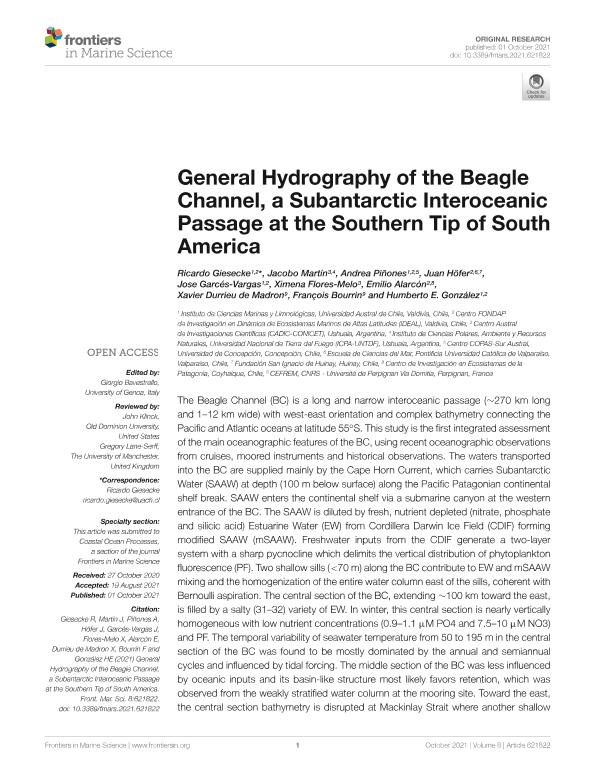Artículo
General Hydrography of the Beagle Channel, a Subantarctic Interoceanic Passage at the Southern Tip of South America
Giesecke Astorga, Claudio Ricardo; Martín de Nascimento, Jacobo ; Piñones, Andrea; Höfer, Juan; Garcés Vargas, Jose; Flores Melo, Elizabeth Ximena
; Piñones, Andrea; Höfer, Juan; Garcés Vargas, Jose; Flores Melo, Elizabeth Ximena ; Alarcón, Emilio; Durrieu de Madron, Xavier; Bourrin, François; González, Humberto E.
; Alarcón, Emilio; Durrieu de Madron, Xavier; Bourrin, François; González, Humberto E.
 ; Piñones, Andrea; Höfer, Juan; Garcés Vargas, Jose; Flores Melo, Elizabeth Ximena
; Piñones, Andrea; Höfer, Juan; Garcés Vargas, Jose; Flores Melo, Elizabeth Ximena ; Alarcón, Emilio; Durrieu de Madron, Xavier; Bourrin, François; González, Humberto E.
; Alarcón, Emilio; Durrieu de Madron, Xavier; Bourrin, François; González, Humberto E.
Fecha de publicación:
10/2021
Editorial:
Frontiers Media
Revista:
Frontiers In Marine Science
ISSN:
2296-7745
Idioma:
Inglés
Tipo de recurso:
Artículo publicado
Clasificación temática:
Resumen
The Beagle Channel (BC) is a long and narrow interoceanic passage (∼270 km long and 1–12 km wide) with west-east orientation and complex bathymetry connecting the Pacific and Atlantic oceans at latitude 55°S. This study is the first integrated assessment of the main oceanographic features of the BC, using recent oceanographic observations from cruises, moored instruments and historical observations. The waters transported into the BC are supplied mainly by the Cape Horn Current, which carries Subantarctic Water (SAAW) at depth (100 m below surface) along the Pacific Patagonian continental shelf break. SAAW enters the continental shelf via a submarine canyon at the western entrance of the BC. The SAAW is diluted by fresh, nutrient depleted (nitrate, phosphate and silicic acid) Estuarine Water (EW) from Cordillera Darwin Ice Field (CDIF) forming modified SAAW (mSAAW). Freshwater inputs from the CDIF generate a two-layer system with a sharp pycnocline which delimits the vertical distribution of phytoplankton fluorescence (PF). Two shallow sills (<70 m) along the BC contribute to EW and mSAAW mixing and the homogenization of the entire water column east of the sills, coherent with Bernoulli aspiration. The central section of the BC, extending ∼100 km toward the east, is filled by a salty (31–32) variety of EW. In winter, this central section is nearly vertically homogeneous with low nutrient concentrations (0.9–1.1 μM PO4 and 7.5–10 μM NO3) and PF. The temporal variability of seawater temperature from 50 to 195 m in the central section of the BC was found to be mostly dominated by the annual and semiannual cycles and influenced by tidal forcing. The middle section of the BC was less influenced by oceanic inputs and its basin-like structure most likely favors retention, which was observed from the weakly stratified water column at the mooring site. Toward the east, the central section bathymetry is disrupted at Mackinlay Strait where another shallow sill separates the middle channel from the shallow eastern entrance that connects to the Atlantic Ocean. In this section, a weakly stratified two-layer system is formed when the eastward surface outflow (salty-EW) flows over a deeper, denser tongue of oceanic mSAAW.
Archivos asociados
Licencia
Identificadores
Colecciones
Articulos(CADIC)
Articulos de CENTRO AUSTRAL DE INVESTIGACIONES CIENTIFICAS
Articulos de CENTRO AUSTRAL DE INVESTIGACIONES CIENTIFICAS
Citación
Giesecke Astorga, Claudio Ricardo; Martín de Nascimento, Jacobo; Piñones, Andrea; Höfer, Juan; Garcés Vargas, Jose; et al.; General Hydrography of the Beagle Channel, a Subantarctic Interoceanic Passage at the Southern Tip of South America; Frontiers Media; Frontiers In Marine Science; 8; 10-2021; 1-21
Compartir
Altmétricas



